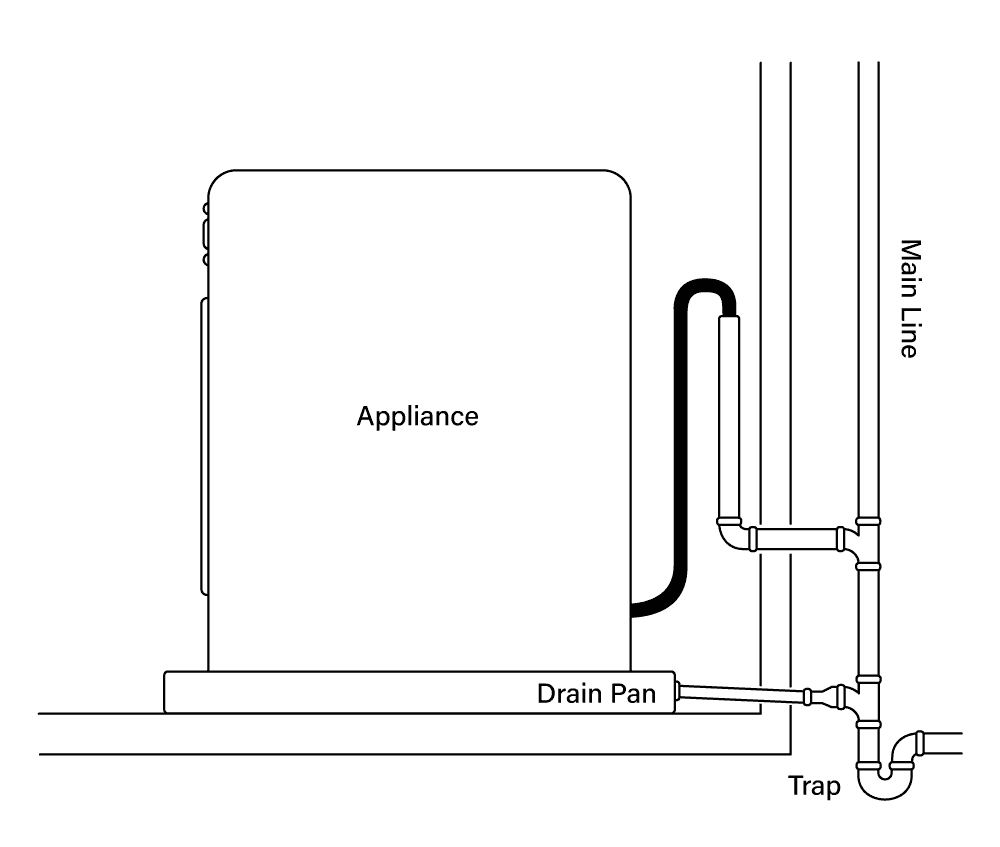Appliance Drain Pan Systems
This resource will describe drain system configurations for drain pans installed under residential and commercial appliances. The information provided should be considered recommendations rather than guidelines suitable for all applications involving alliances with drain pans.
What is an Appliance Drain Pan?
Appliance Drain Pans are containment systems, made most often from metal or plastic materials. These pans are installed under appliances in a residential or commercial setting to prevent leaks within the appliance from damaging building materials or causing mold and mildew development within the structure. An Appliance Drain Pan will be equipped with a drain hole, can vary in size, for connecting the pan to a drain pipe within the residence that will transfer fluid leaked into the pan to an area on the exterior of the home.
Typical Appliance Drain Pan Configurations
Drain systems within a residential or commercial structure can either terminate in the main drain lines that connect to the septic system or may proceed through an exterior wall to all liquid to drain outside the structure. Sink drains are an example of the former and air conditioner condensate drains are an example of the latter. Below are a couple of the possible drain system configurations used with Appliance Drain Pans:
Draining Into Main Drain Line
An appliance drain pan may be connected directly to a main drain line. For example, a washing machine drain pan may connect to the drain line utilized to drain the contents of the washing machine during its cycle. This configuration requires a properly sized Y pipe fitting to accommodate the junction of the drain pan piping with the main drain line.

Note that it is likely that the drain line from the drain pan and the main drain line will not be of the same diameter. For this reason, it is common to use a reducer coupling to fit the drain pan line into the main line.

In this configuration it is recommended that the drain line for the Appliance Drain Pan is connected above any trap installed in the main drain line. This will prevent the escape of odorous fumes from the drain line through the drain pan line. If the drain line for the pan is connected below the mainline trap it will be necessary to install a trap on this line for capture of fumes within the drain line.

Considerations:
- The Appliance Drain Pan line must have at least a 1/4” downward slope, with the pan drain hole being at a higher elevation than the junction of the drain pipe and main line. The drain line from the pan must proceed in a downward course from the pan to the main drain line junction to allow for proper gravity drainage.
- Connect drain line above the trap on the main drain line to prevent odor from escaping.
- Use properly sized fittings and ensure a proper seal at the main drain line junction.
- Utilizing a configuration that connects your Appliance Drain Pan drain line to the main drain line used to drain the appliance itself can potentially create an overflow situation if the main drain line has a blockage.
Dedicated Drain Line to Exterior of Structure
If your structure allows for use of a dedicated drain line to your Appliance Drain Pan, this may be the ideal configuration for your application. In order to use a dedicated drain line there will need to be a clear path for the drain line to an exterior wall so that any fluid expelled through the drain system may be delivered outside of the structure. In this configuration the dedicated drain line will be connected directly to the drain pan fitting installed in the drain hole of the Appliance Drain Pan.

Considerations:
- The Appliance Drain Pan line must have at least a 1/4” downward slope and have a direct path to an exterior wall of the structure. The drain line from the pan must proceed in a downward course from the pan to outside the exterior wall of the structure to allow for proper gravity drainage.
- The dedicated drain line system should never be used to drain fluids that are hazardous, corrosive or require treatment to prevent environmental damage.
In all applications for Appliance Drain Pan drain systems it is recommended and helpful to consult with a professional plumber. For more information on Killarney Metals’ drain pans click here (link to products) or contact our helpful staff at 704-755-8002.